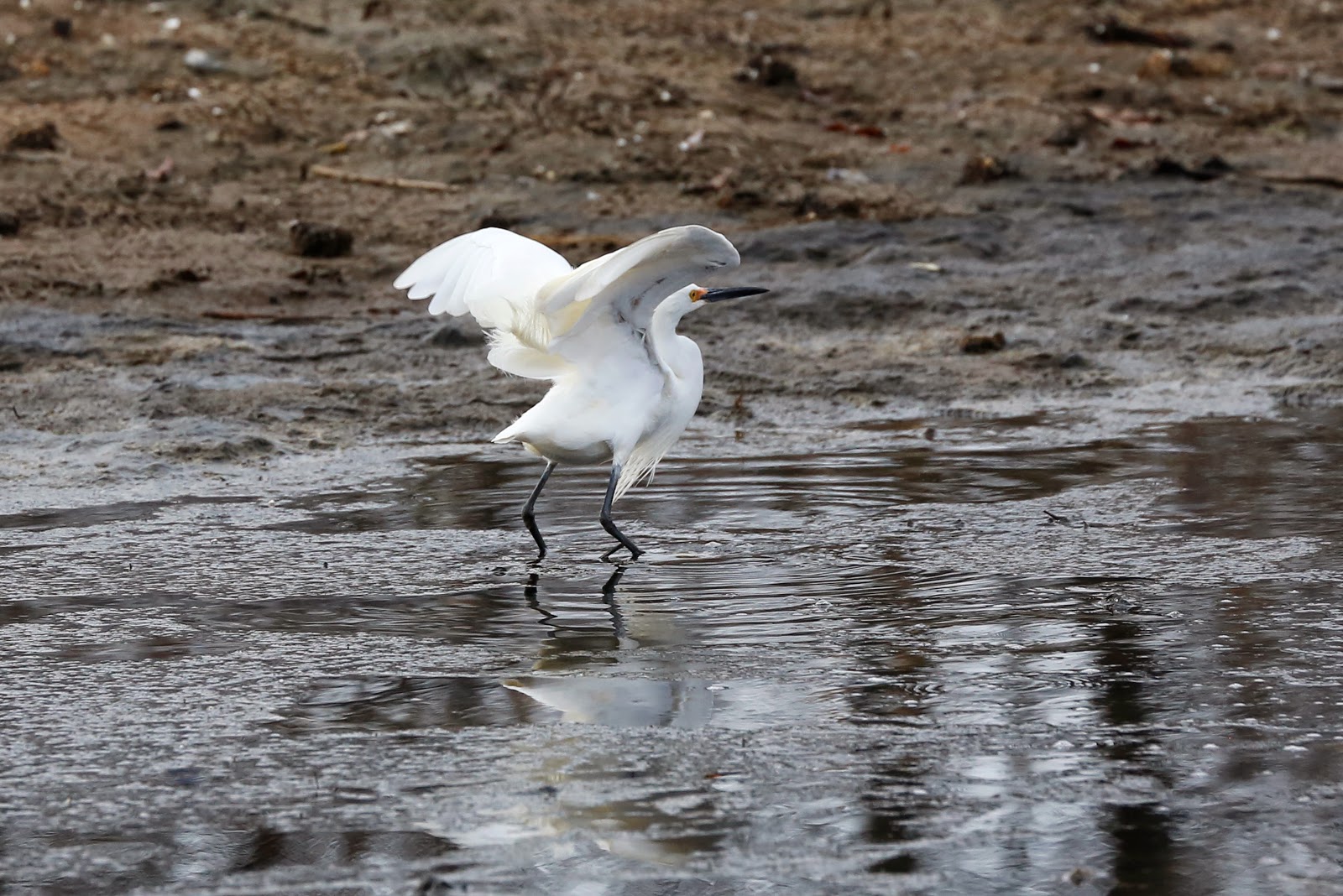Snowy Egret - Czapla śnieżna
New York, Jamaica Bay, 2014
Description
Adults are typically 61 centimeters (24 in) long and weigh 375 grams (13.2 oz.)
They have a slim black bill and long black legs with yellow feet. The area of the upper bill, in front of the eyes, is yellow but turns red during the breeding season, when the adults also gain recurved plumes on the back, making for a "shaggy" effect.
The juvenile looks similar to the adult, but the base of the bill is paler, and a green or yellow line runs down the back of the legs.
Habitat
Snowy Egrets nest in colonies on thick vegetation in isolated places—such as barrier islands, dredge-spoil islands, salt marsh islands, swamps, and marshes. They often change location from year to year. During the breeding season Snowy Egrets feed in estuaries, saltmarshes, tidal channels, shallow bays, and mangroves. They winter in mangroves, saltwater lagoons, freshwater swamps, grassy ponds, and temporary pools, and forage on beaches, shallow reefs, and wet fields.
Voice
Snowy Egrets are quiet except on breeding sites, where they give raspy or nasal calls, including loud, harsh squawks to signal aggression.
Snowy Egrets are quiet except on breeding sites, where they give raspy or nasal calls, including loud, harsh squawks to signal aggression.
Diet
The Snowy Egret eats mostly aquatic animals, including fish, frogs, worms, crustaceans, and insects. It often uses its bright yellow feet to paddle in the water or probe in the mud, rounding up prey before striking with its bill. Snowy Egrets feed while standing, walking, running, or hopping, and they may vibrate their bills, sway their heads, or flick their wings as part of prey gathering. They even forage while hovering. Snowy Egrets forage in saltmarsh pools, tidal channels, tidal flats, freshwater marshes, swamps, ocean inlets, and lake edges, usually preferring brackish or marine habitats with shallow water. Other foraging water birds often assemble around them to form mixed-species foraging groups.
Reproduction
The male starts working on a nest before finding a mate. Then the female takes over and ends up doing most of the nest building, with materials supplied by the male. The nest is a shallow oval of loosely woven twigs, small sticks, grasses, sedges, rushes, and Spanish moss, about 14–18 inches across and 8–13 inches high. Three to four greenish-blue, oval eggs are incubated by both adults. The young leave the nest in 20 to 25 days and hop about on branches near the nest before finally departing.
Males establish nesting territories and choose nest sites within the thick vegetation of a breeding colony. The nest is usually in the top or outer branches of a woody vine, shrub, or tree.
Male Snowy Egrets fight for breeding territories, choose nest sites, and perform noisy courtship displays to attract mates. A ring of other egrets often gathers around a displaying male as he pumps his body up and down, points his bill skyward, and calls. He also performs aerial displays, including one that ends with him dropping toward the ground while tumbling around and around. After pairing up, Snowy Egrets continue defending the immediate area around the nest, raising their crests and giving rasping calls. Some of their nest predators include raccoons, Great Horned Owls, Barred Owls, American Crows, Fish Crows, American alligators, and gray rat snakes. Highly social all year long, Snowy Egrets forage with gulls, terns, ibises, and other herons, and they nest in colonies alongside many other species, including Great Egrets, night-herons, Glossy Ibises, Little Blue Herons, Tricolored Herons, Cattle Egrets, and Roseate Spoonbills.
Did you know?
Male and female Snowy Egrets take turns incubating their eggs. As one mate takes over for the other, it sometimes presents a stick, almost as if passing a baton. Both parents continue caring for the young when they hatch.
During the breeding season, adult Snowy Egrets develop long, wispy feathers on their backs, necks, and heads. In 1886 these plumes were valued at $32 per ounce, which was twice the price of gold at the time. Plume-hunting for the fashion industry killed many Snowy Egrets and other birds until reforms were passed in the early twentieth century. The recovery of shorebird populations through the work of concerned citizens was an early triumph and helped give birth to the conservation movement.
Adult Snowy Egrets have greenish-yellow feet for most of the year, but at the height of the breeding season their feet take on a much richer, orange-yellow hue. The bare skin on their face also changes color, from yellow to reddish.
Snowy Egrets sometimes mate with other heron species and produce hybrid offspring. They have been known to hybridize with Tricolored Herons, Little Blue Herons, and Cattle Egrets.
The oldest Snowy Egret on record was at least 17 years, 7 months old.
Photos by others
Ian Barker
Ron Reznick
Credits
Cornell Lab of Ornithology











No comments:
Post a Comment